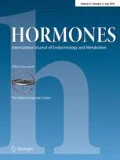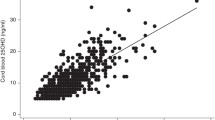Abstract
OBJECTIVE
To investigate whether maternal serum concentrations of placental growth hormone (GH-V), insulin-like growth factor (IGF) 1 and 2, and IGF binding proteins (IGFBP) 1 and 3 were altered in pregnancies complicated by gestational diabetes mellitus (GDM).
METHOD
In a nested case-control study, GDM cases (n=28) and matched controls (n=28) were selected from the Screening for Pregnancy Endpoints (SCOPE) biobank in Auckland, New Zealand. Maternal serum hormone concentrations at 20 weeks of gestation were determined by enzyme-linked immunosorbent assay (ELISA).
RESULTS
There was no significant difference in maternal serum GH-V concentration in the GDM group compared to the control group (1.64 ± 0.11 ng/ml vs. 1.38 ± 0.10 ng/ml, p=0.079). However, GDM cases who delivered large for gestational age (LGA) babies had significantly higher serum GH-V concentrations compared to non-diabetic control cases. Maternal IGF-1 concentrations in GDM pregnancies were significantly higher than in controls (275.7 ± 11.5 ng/ml vs. 218.5 ± 11.1 ng/ml, p <0.001). Maternal IGFBP-1 concentrations were significantly lower in GDM pregnancies than in controls (41.04 ± 3.42 ng/ml vs. 67.58 ± 6.17 ng/ml, p <0.001). There were no significant differences in serum IGF-2 and IGFBP-3 concentrations between groups.
CONCLUSION
Concentrations of IGF-1 and IGFBP-1 in maternal serum were altered in GDM pregnancies compared to controls, suggesting that the IGF axis plays a role in the development of this condition. GH-V may be associated with macrosomia as increased maternal GH-V was observed in GDM cases who delivered LGA babies.
Similar content being viewed by others
References
Colagiuri S, Falavigna M, Agarwal MM, et al, 2014 Strategies for implementing the WHO diagnostic criteria and classification of hyperglycaemia first detected in pregnancy. Diabetes Res Clin Pract 103: 364–372.
Zhu Y, Zhang C, 2016 Prevalence of Gestational Diabetes and Risk of Progression to Type 2 Diabetes: a Global Perspective. Curr Diab Rep 16: 7.
Langer O, Yogev Y, Most OXenakis EM, 2005 Gestational diabetes: the consequences of not treating. Am J Obstet Gynecol 192: 989–997.
Catalano PM, Kirwan JP, Haugel-de Mouzon SKing J, 2003 Gestational diabetes and insulin resistance: role in short- and long-term implications for mother and fetus. J Nutr 133: 5 Suppl 2: 1674–1683.
Hirt H, Kimelman J, Birnbaum MJ, et al, 1987 The human growth hormone gene locus: structure, evolution, and allelic variations. DNA 6: 59–70.
Alsat E, Guibourdenche J, Luton D, Frankenne FEvain-Brion D. 1997 Human placental growth hormone. Am J Obstet Gynecol 177: 1526–1534.
Alsat E, Guibourdenche J, Couturier AE, vain-Brion D. 1998 Physiological role of human placental growth hormone. Mol Cell Endocrinol 140: 121–127.
Eriksson L, Frankenne F, Eden S, Hennen G, Von Schoultz B, 1989 Growth hormone 24-h serum profiles during pregnancy—lack of pulsatility for the secretion of the placental variant. Br J Obstet Gynaecol 96: 949–953.
Newbern D, Freemark M, 2011 Placental hormones and the control of maternal metabolism and fetal growth. Curr Opin Endocrinol Diabetes Obes 18: 409–416.
Barbour LA, Shao J, Qiao L, et al, 2002 Human placental growth hormone causes severe insulin resistance in transgenic mice. Am J Obstet Gynecol 186: 512–517.
Liao S, Vickers MH, Stanley JL, et al, 2016 The Placental Variant of Human Growth Hormone Reduces Maternal Insulin Sensitivity in a Dose-Dependent Manner in C57BL/6J Mice. Endocrinology 157: 1175–1186.
Liao S, Vickers MH, Evans A, et al, 2016 Comparison of pulsatile vs. continuous administration of human placental growth hormone in female C57BL/6J mice. Endocrine: 1–13.
Chellakooty M, Vangsgaard K, Larsen T, et al, 2004 A longitudinal study of intrauterine growth and the placental growth hormone (GH)-insulin-like growth factor I axis in maternal circulation: association between placental GH and fetal growth. J Clin Endocrinol Metab 89: 384–391.
McIntyre HD, Serek R, Crane DI, et al, 2000 Placental growth hormone (GH), GH-binding protein, and insulin-like growth factor axis in normal, growth-retarded, and diabetic pregnancies: correlations with fetal growth. J Clin Endocrinol Metab 85: 1143–1150.
Pedersen NG, Juul A, Christiansen M, Wojdemann KRTabor A, 2010 Maternal serum placental growth hormone, but not human placental lactogen or insulin growth factor-1, is positively associated with fetal growth in the first half of pregnancy. Ultrasound Obst Gyn 36: 534–541.
Liao S, Vickers MH, Taylor RS, et al, 2016 Human placental growth hormone is increased in maternal serum at 20 weeks of gestation in pregnancies with large-for-gestational-age babies. Growth Factors 34: 203–209.
Caufriez A, Frankenne F, Hennen G, Copinschi G. 1993 Regulation of maternal IGF-I by placental GH in normal and abnormal human pregnancies. Am J Physiol 265: E572–577.
Caufriez A, Frankenne F, Hennen G, Copinschi G, 1994 Regulation of maternal insulin-like growth factor I by placental growth hormone in pregnancy. Possible action of maternal IGF-I on fetal growth. Horm Res 42: 62–65.
Caufriez A, Frankenne F, Englert Y, et al, 1990 Placental growth hormone as a potential regulator of maternal IGF-I during human pregnancy. Am J Physiol 258: E1014–E1019.
Forbes K, Westwood M, 2008 The IGF axis and placental function, a mini review. Horm Res 69: 129–137.
Chard T, 1994 Insulin-like growth factors and their binding proteins in normal and abnormal human fetal growth. Growth Regul 4: 91–100.
Holt RI, Simpson HL, Sonksen PH, 2003 The role of the growth hormone-insulin-like growth factor axis in glucose homeostasis. Diabet Med 20: 3–15.
Fuglsang J, Lauszus F, Flyvbjerg A, Ovesen P, 2003 Human placental growth hormone, insulin-like growth factor I and -II, and insulin requirements during pregnancy in type 1 diabetes. J Clin Endocrinol Metab 88: 4355–4361.
Matuszek B, Lenart-Lipinska M, Burska A, et al, 2011 Increased serum insulin-like growth factor-1 levels in women with gestational diabetes. Adv Med Sci 56: 200–206.
Yan-Jun L, Tsushima T, Minei S, et al, 1996 Insulin-like growth factors (IGFs) and IGF-binding proteins (IGFBP-1, -2 and -3) in diabetic pregnancy: relationship to macrosomia. Endocrine Journal 43: 221–231.
Zhu Y, Mendola P, Albert PS, et al, 2016 Insulin-like growth factor axis and gestational diabetes: A longitudinal study in a multiracial cohort. Diabetes.
McCowan L, North RTaylor R. (2007).
Simmons D, Rowan J, Reid R, Campbell N, 2008 Screening, diagnosis and services for women with gestational diabetes mellitus (GDM) in New Zealand: a technical report from the National GDM Technical Working Party. N Z Med J 121: 74–86.
Solomon G, Reicher S, Gussakovsky EE, Jomain JB, Gertler A, 2006 Large-scale preparation and in vitro characterization of biologically active human placental (20 and 22K) and pituitary (20K) growth hormones: placental growth hormones have no lactogenic activity in humans. Growth Horm IGF Res 16: 297–307.
Liao S, Vickers MH, Taylor RS, et al, Human placental growth hormone is increased in maternal serum at 20 weeks of gestation in pregnancies with large-for-gestational-age babies. Growth Factors 2016 Dec;34(5–6):203–209. doi: https://doi.org/10.1080/08977194.08972016.01273223.
Patel N, Alsat E, Igout A, et al, 1995 Glucose inhibits human placental GH secretion, in vitro. J Clin Endocrinol Metab 80: 1743–1746.
Bjorklund AO, Adamson UK, Carlstrom KA, et al, 1998 Placental hormones during induced hypoglycaemia in pregnant women with insulin-dependent diabetes mellitus: evidence of an active role for placenta in hormonal counter-regulation. Br J Obstet Gynaecol 105: 649–655.
Higgins MF, Russell NE, Crossey PA, et al, 2012 Maternal and fetal placental growth hormone and IGF axis in type 1 diabetic pregnancy. PLoS One 7: e29164.
Verhaeghe J, Pintiaux A, Van Herck E, et al, 2002 Placental GH, IGF-I, IGF-binding protein-1, and leptin during a glucose challenge test in pregnant women: relation with maternal body weight, glucose tolerance, and birth weight. J Clin Endocrinol Metab 87: 2875–2882.
Fuglsang J, Lauszus FF, Fisker S, Flyvbjerg A, Ovesen P, 2005 Growth hormone binding protein and maternal body mass index in relation to placental growth hormone and insulin requirements during pregnancy in type 1 diabetic women. Growth Horm IGF Res 15: 223–230.
Clemmons DR, 2004 The relative roles of growth hormone and IGF-1 in controlling insulin sensitivity. J Clin Invest 113: 25–27.
Baxter RC, 1994 Insulin-like growth factor binding proteins in the human circulation: a review. Horm Res 42: 140–144.
Wheatcroft SB, Kearney MT, 2009 IGF-dependent and IGF-independent actions of IGF-binding protein-1 and -2: implications for metabolic homeostasis. Trends Endocrinol Metab 20: 153–162.
Collett-Solberg PF, Cohen P, 1996 The role of the insulin-like growth factor binding proteins and the IGFBP proteases in modulating IGF action. Endocrinol Metab Clin North Am 25: 591–614.
Kim HS, 2013 Role of insulin-like growth factor binding protein-3 in glucose and lipid metabolism. Ann Pediatr Endocrinol Metab 18: 9–12.
Kim HS, Ali O, Shim M, et al, 2007 Insulin-like growth factor binding protein-3 induces insulin resistance in adipocytes in vitro and in rats in vivo. Pediatr Res 61: 159–164.
Yamada PM, Mehta HH, Hwang D, et al, 2010 Evidence of a role for insulin-like growth factor binding protein (IGFBP)-3 in metabolic regulation. Endocrinology 151: 5741–5750.
Mohanraj L, Kim HS, Li W, et al, 2013 IGFBP-3 inhibits cytokine-induced insulin resistance and early manifestations of atherosclerosis. PLoS One 8: e55084.
Lee PD, Giudice LC, Conover CA, Powell DR, 1997 Insulin-like growth factor binding protein-1: recent findings and new directions. Proc Soc Exp Biol Med 216: 319–357.
Lewitt MS, Denyer GS, Cooney GJ, Baxter RC, 1991 Insulin-like growth factor-binding protein-1 modulates blood glucose levels. Endocrinology 129: 2254–2256.
Katz LE, DeLeon DD, Zhao H, Jawad AF, 2002 Free and total insulin-like growth factor (IGF)-I levels decline during fasting: relationships with insulin and IGF-binding protein-1. J Clin Endocrinol Metab 87: 2978–2983.
Rajkumar K, Krsek M, Dheen ST, Murphy LJ, 1996 Impaired glucose homeostasis in insulin-like growth factor binding protein-1 transgenic mice. J Clin Invest 98: 1818–1825.
Buyalos RP, Pekonen F, Halme JK, Judd HL, Rutanen EM, 1995 The relationship between circulating androgens, obesity, and hyperinsulinemia on serum insulin-like growth factor binding protein-1 in the polycystic ovarian syndrome. Am J Obstet Gynecol 172: 932–939.
Mogul HR, Marshall M, Frey M, et al, 1996 Insulin like growth factor-binding protein-1 as a marker for hyperinsulinemia in obese menopausal women. J Clin Endocrinol Metab 81: 4492–4495.
Luo ZC, Nuyt AM, Delvin E, et al, 2012 Maternal and fetal IGF-I and IGF-II levels, fetal growth, and gestational diabetes. J Clin Endocrinol Metab 97: 1720–1728.
Ramirez VI, Miller E, Meireles CL, et al, 2014 Adiponectin and IGFBP-1 in the development of gestational diabetes in obese mothers. BMJ Open Diabetes Res Care 2: e000010.
Hughes SC, Johnson MR, Heinrich GHolly JM, 1995 Could abnormalities in insulin-like growth factors and their binding proteins during pregnancy result in gestational diabetes? J Endocrinol 147: 517–524.
Qiu C, Vadachkoria S, Meryman L, Frederick IO, Williams MA, 2005 Maternal plasma concentrations of IGF-1, IGFBP-1, and C-peptide in early pregnancy and subsequent risk of gestational diabetes mellitus. Am J Obstet Gynecol 193: 1691–1697.
Verhaeghe J, 2008 Does the physiological acromegaly of pregnancy benefit the fetus? Gynecol Obstet Invest 66: 217–226.
Author information
Authors and Affiliations
Corresponding author
Rights and permissions
About this article
Cite this article
Liao, S., Vickers, M.H., Taylor, R.S. et al. Maternal serum placental growth hormone, insulin-like growth factors and their binding proteins at 20 weeks’ gestation in pregnancies complicated by gestational diabetes mellitus. Hormones 16, 282–290 (2017). https://doi.org/10.1007/BF03401522
Received:
Accepted:
Published:
Issue Date:
DOI: https://doi.org/10.1007/BF03401522




